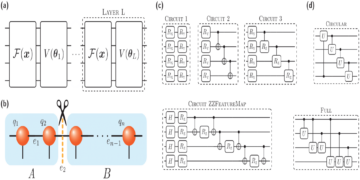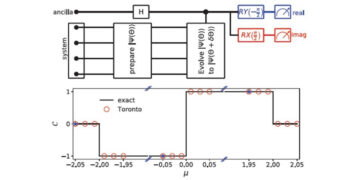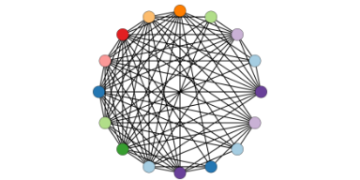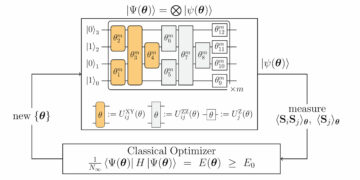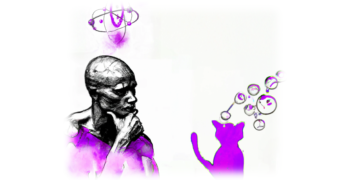1Computer, Computational, and Statistical Sciences Division, Los Alamos National Laboratory, Los Alamos, NM 87545, USA
2Theoretical Division, Los Alamos National Laboratory, Los Alamos, NM 87545, USA
Find this paper interesting or want to discuss? Scite or leave a comment on SciRate.
Abstract
Fluctuation theorems provide a correspondence between properties of quantum systems in thermal equilibrium and a work distribution arising in a non-equilibrium process that connects two quantum systems with Hamiltonians $H_0$ and $H_1=H_0+V$. Building upon these theorems, we present a quantum algorithm to prepare a purification of the thermal state of $H_1$ at inverse temperature $beta ge 0$ starting from a purification of the thermal state of $H_0$. The complexity of the quantum algorithm, given by the number of uses of certain unitaries, is $tilde {cal O}(e^{beta (Delta ! A- w_l)/2})$, where $Delta ! A$ is the free-energy difference between $H_1$ and $H_0,$ and $w_l$ is a work cutoff that depends on the properties of the work distribution and the approximation error $epsilongt0$. If the non-equilibrium process is trivial, this complexity is exponential in $beta |V|$, where $|V|$ is the spectral norm of $V$. This represents a significant improvement of prior quantum algorithms that have complexity exponential in $beta |H_1|$ in the regime where $|V|ll |H_1|$. The dependence of the complexity in $epsilon$ varies according to the structure of the quantum systems. It can be exponential in $1/epsilon$ in general, but we show it to be sublinear in $1/epsilon$ if $H_0$ and $H_1$ commute, or polynomial in $1/epsilon$ if $H_0$ and $H_1$ are local spin systems. The possibility of applying a unitary that drives the system out of equilibrium allows one to increase the value of $w_l$ and improve the complexity even further. To this end, we analyze the complexity for preparing the thermal state of the transverse field Ising model using different non-equilibrium unitary processes and see significant complexity improvements.
► BibTeX data
► References
[1] N. Metropolis, A. W. Rosenbluth, M. N. Rosenbluth, A. H. Teller, and E. Teller. Equations of state calculations by fast computing machines. Journal of Chemical Physics, 21:1087–1092, 1953. doi:10.1063/1.1699114.
https://doi.org/10.1063/1.1699114
[2] L.D. Landau and E.M Lifshitz. Statistical physics: Part I. Butterworth-Heinemann, Oxford, 1951.
[3] M. Suzuki. Quantum Monte Carlo Methods in Equilibrium and Nonequilibrium Systems. Springer Ser. Solid-State Sci. 74, Springer, 1987. doi:10.1007/978-3-642-83154-6.
https://doi.org/10.1007/978-3-642-83154-6
[4] Daniel A. Lidar and Ofer Biham. Simulating ising spin glasses on a quantum computer. Phys. Rev. E, 56:3661, 1997. doi:10.1103/PhysRevE.56.3661.
https://doi.org/10.1103/PhysRevE.56.3661
[5] B.M. Terhal and D.P. DiVincenzo. Problem of equilibration and the computation of correlation functions on a quantum computer. Phys. Rev. A, 61:022301, 2000. doi:10.1103/PhysRevA.61.022301.
https://doi.org/10.1103/PhysRevA.61.022301
[6] R. D. Somma, S. Boixo, H. Barnum, and E. Knill. Quantum simulations of classical annealing processes. Phys. Rev. Lett., 101:130504, 2008. doi:10.1103/PhysRevLett.101.130504.
https://doi.org/10.1103/PhysRevLett.101.130504
[7] K. Temme, T.J. Osborne, K. Vollbrecht, D. Poulin, and F. Verstraete. Quantum metropolis sampling. Nature, 471:87–90, 2011. doi:10.1038/nature09770.
https://doi.org/10.1038/nature09770
[8] C. Chipot and A. Pohorille. Free energy calculations: Theory and applications in chemistry and biology. Springer Verlag, New York, 2007. doi:10.1007/978-3-540-38448-9.
https://doi.org/10.1007/978-3-540-38448-9
[9] T.A. van der Straaten, G. Kathawala, A. Trellakis, R.S. Eisenberg, and U. Ravaioli. Biomoca— a boltzmann transport monte carlo model for ion channel simulation. Molecular Simulation, 31:151–171, 2005. doi:10.1080/08927020412331308700.
https://doi.org/10.1080/08927020412331308700
[10] D. P. Kroese and J. C. C. Chan. Statistical Modeling and Computation. Springer, New York, 2014. doi:10.1007/978-1-4614-8775-3.
https://doi.org/10.1007/978-1-4614-8775-3
[11] S. Kirkpatrick, C.D. Gelatt Jr., and M.P. Vecchi. Optimization by simulated annealing. Science, 220:671–680, 1983. doi:10.1126/science.220.4598.671.
https://doi.org/10.1126/science.220.4598.671
[12] L. Lovász. Randomized algorithms in combinatorial optimization. DIMACS Series in Discrete Mathematics and Theoretical Computer Science, 20:153–179, 1995. doi:10.1090/dimacs/020.
https://doi.org/10.1090/dimacs/020
[13] M.E.J. Newman and G.T. Barkema. Monte Carlo Methods in Statistical Physics. Oxford University Press, Oxford, 1998.
[14] M.P. Nightingale and C.J. Umrigar. Quantum Monte Carlo Methods in Physics and Chemistry. Springer, Netherlands, 1999.
[15] E.Y. Loh, J.E. Gubernatis, R.T. Scalettar, S.R. White, D.J. Scalapino, and R.L. Sugar. Sign problem in the numerical simulation of many-electron systems. Phys. Rev. B, 41:9301–9307, 1990. doi:10.1103/PhysRevB.41.9301.
https://doi.org/10.1103/PhysRevB.41.9301
[16] Matthias Troyer and Uwe-Jens Wiese. Computational complexity and fundamental limitations to fermionic quantum monte carlo simulations. Phys. Rev. Lett., 94:170201, 2005. doi:10.1103/PhysRevLett.94.170201.
https://doi.org/10.1103/PhysRevLett.94.170201
[17] David Poulin and Pawel Wocjan. Sampling from the thermal quantum gibbs state and evaluating partition functions with a quantum computer. Phys. Rev. Lett., 103:220502, 2009. doi:10.1103/PhysRevLett.103.220502.
https://doi.org/10.1103/PhysRevLett.103.220502
[18] C.F. Chiang and P. Wocjan. Quantum algorithm for preparing thermal gibbs states-detailed analysis. In Quantum Cryptography and Computing, pages 138–147, 2010. doi:10.48550/arXiv.1001.1130.
https://doi.org/10.48550/arXiv.1001.1130
[19] Ersen Bilgin and Sergio Boixo. Preparing thermal states of quantum systems by dimension reduction. Phys. Rev. Lett., 105:170405, 2010. doi:10.1103/PhysRevLett.105.170405.
https://doi.org/10.1103/PhysRevLett.105.170405
[20] Michael J. Kastoryano and Fernando G. S. L. Brandão. Quantum gibbs samplers: the commuting case. Comm. Math. Phys., 344:915, 2016. doi:10.48550/arXiv.1409.3435.
https://doi.org/10.48550/arXiv.1409.3435
[21] Anirban Narayan Chowdhury and Rolando D. Somma. Quantum algorithms for gibbs sampling and hitting-time estimation. Quant. Inf. Comp., 17(1–2):41–64, 2017. doi:10.48550/arXiv.1603.02940.
https://doi.org/10.48550/arXiv.1603.02940
[22] Tomotaka Kuwahara, Kohtaro Kato, and Fernando G. S. L. Brandão. Clustering of conditional mutual information for quantum gibbs states above a threshold temperature. Phys. Rev. Lett., 124:220601, 2020. doi:10.1103/PhysRevLett.124.220601.
https://doi.org/10.1103/PhysRevLett.124.220601
[23] Mario Szegedy. Quantum speed-up of markov chain based algorithms. In Proceedings of the 45th Annual IEEE Symposium on FOCS., pages 32–41. IEEE, 2004. doi:10.1109/FOCS.2004.53.
https://doi.org/10.1109/FOCS.2004.53
[24] F. G. S. L. Brandão and K. M. Svore. Quantum speed-ups for solving semidefinite programs. In 2017 IEEE 58th Annual Symposium on Foundations of Computer Science (FOCS), pages 415–426, 2017.
[25] J. Van Apeldoorn, A. Gilyén, S. Gribling, and R. de Wolf. Quantum sdp-solvers: Better upper and lower bounds. In 2017 IEEE 58th Annual Symposium on Foundations of Computer Science (FOCS), pages 403–414, 2017. doi:10.48550/arXiv.1609.05537.
https://doi.org/10.48550/arXiv.1609.05537
[26] Seth Lloyd. Universal quantum simulators. Science, 273:1073–1078, 1996. doi:10.1126/science.273.5278.1073.
https://doi.org/10.1126/science.273.5278.1073
[27] R. D. Somma, G. Ortiz, J. E. Gubernatis, E. Knill, and R. Laflamme. Simulating physical phenomena by quantum networks. Phys. Rev. A, 65:042323, 2002. doi:10.1103/PhysRevA.65.042323.
https://doi.org/10.1103/PhysRevA.65.042323
[28] R. D. Somma, G. Ortiz, E. Knill, and J. E. Gubernatis. Quantum simulations of physics problems. Int. J. Quant. Inf., 1:189, 2003. doi:10.1117/12.487249.
https://doi.org/10.1117/12.487249
[29] D.W. Berry, G. Ahokas, R. Cleve, and B.C. Sanders. Efficient quantum algorithms for simulating sparse hamiltonians. Comm. Math. Phys., 270:359, 2007. doi:10.1007/s00220-006-0150-x.
https://doi.org/10.1007/s00220-006-0150-x
[30] N. Wiebe, D. Berry, P. Hoyer, and B.C. Sanders. Higher order decompositions of ordered operator exponentials. J. Phys. A: Math. Theor., 43:065203, 2010. doi:10.1088/1751-8113/43/6/065203.
https://doi.org/10.1088/1751-8113/43/6/065203
[31] A. M. Childs and N. Wiebe. Hamiltonian simulation using linear combinations of unitary operations. Quantum Information and Computation, 12:901–924, 2012. doi:10.48550/arXiv.1202.5822.
https://doi.org/10.48550/arXiv.1202.5822
[32] Dominic W. Berry, Andrew M. Childs, Richard Cleve, Robin Kothari, and Rolando D. Somma. Simulating hamiltonian dynamics with a truncated taylor series. Phys. Rev. Lett., 114:090502, 2015. doi:10.1103/PhysRevLett.114.090502.
https://doi.org/10.1103/PhysRevLett.114.090502
[33] G.H. Low and I.L. Chuang. Optimal hamiltonian simulation by quantum signal processing. Phys. Rev. Lett., 118:010501, 2017. doi:10.1103/PhysRevLett.118.010501.
https://doi.org/10.1103/PhysRevLett.118.010501
[34] U. Wolff. Critical slowing down. Nuclear Phys. B, 17:93–102, 1990. doi:10.1016/0920-5632(90)90224-I.
https://doi.org/10.1016/0920-5632(90)90224-I
[35] A.Y. Kitaev, A.H. Shen, and M.N Vyalyi. Classical and Quantum Computation. American Mathematical Society, 2002. URL: http://doi.org/10.1090/gsm/047, doi:10.1090/gsm/047.
https://doi.org/10.1090/gsm/047
[36] C. Jarzynski. Equilibrium free-energy differences from nonequilibrium measurements: A master-equation approach. Phys. Rev. E, 56:5018–5035, 1997. doi:10.1103/PhysRevE.56.5018.
https://doi.org/10.1103/PhysRevE.56.5018
[37] C. Jarzynski. Nonequilibrium equality for free energy differences. Phys. Rev. Lett., 78:2690–2693, 1997. doi:10.1103/PhysRevLett.78.2690.
https://doi.org/10.1103/PhysRevLett.78.2690
[38] Christopher Jarzynski. Equalities and inequalities: Irreversibility and the second law of thermodynamics at the nanoscale. Annual Review of Condensed Matter Physics, 2(1):329–351, 2011. arXiv:https://doi.org/10.1146/annurev-conmatphys-062910-140506, doi:10.1146/annurev-conmatphys-062910-140506.
https://doi.org/10.1146/annurev-conmatphys-062910-140506
arXiv:https://doi.org/10.1146/annurev-conmatphys-062910-140506
[39] Gavin E. Crooks. Entropy production fluctuation theorem and the nonequilibrium work relation for free energy differences. Phys. Rev. E, 60:2721–2726, 1999. doi:10.1103/PhysRevE.60.2721.
https://doi.org/10.1103/PhysRevE.60.2721
[40] Gavin E. Crooks. Path-ensemble averages in systems driven far from equilibrium. Phys. Rev. E, 61:2361–2366, 2000. doi:10.1103/PhysRevE.61.2361.
https://doi.org/10.1103/PhysRevE.61.2361
[41] Augusto J. Roncaglia, Federico Cerisola, and Juan Pablo Paz. Work measurement as a generalized quantum measurement. Phys. Rev. Lett., 113:250601, 2014. doi:10.1103/PhysRevLett.113.250601.
https://doi.org/10.1103/PhysRevLett.113.250601
[42] Lindsay Bassman, Katherine Klymko, Diyi Liu, Norman M Tubman, and Wibe A de Jong. Computing free energies with fluctuation relations on quantum computers. arXiv preprint arXiv:2103.09846, 2021. doi:10.48550/arXiv.2103.09846.
https://doi.org/10.48550/arXiv.2103.09846
arXiv:2103.09846
[43] S. Barnett. Quantum information, volume 16. Oxford University Press, 2009.
[44] M. Nielsen and I. Chuang. Quantum Computation and Quantum Information. Cambridge University Press, Cambridge, 2001. doi:10.1017/CBO9780511976667.
https://doi.org/10.1017/CBO9780511976667
[45] Emanuel Knill, Gerardo Ortiz, and Rolando D. Somma. Optimal quantum measurements of expectation values of observables. Phys. Rev. A, 75:012328, 2007. doi:10.1103/PhysRevA.75.012328.
https://doi.org/10.1103/PhysRevA.75.012328
[46] Guang Hao Low and Isaac L Chuang. Hamiltonian simulation by qubitization. Quantum, 3:163, 2019. doi:10.22331/q-2019-07-12-163.
https://doi.org/10.22331/q-2019-07-12-163
[47] Christopher Jarzynski. Rare events and the convergence of exponentially averaged work values. Phys. Rev. E, 73:046105, 2006. doi:10.1103/PhysRevE.73.046105.
https://doi.org/10.1103/PhysRevE.73.046105
[48] Yu Tong, Dong An, Nathan Wiebe, and Lin Lin. Fast inversion, preconditioned quantum linear system solvers, fast green’s-function computation, and fast evaluation of matrix functions. Phys. Rev. A, 104:032422, Sep 2021. doi:10.1103/PhysRevA.104.032422.
https://doi.org/10.1103/PhysRevA.104.032422
[49] A. Kitaev. Quantum measurements and the Abelian stabilizer problem. arXiv:quant-ph/9511026, 1995. doi:10.48550/arXiv.quant-ph/9511026.
https://doi.org/10.48550/arXiv.quant-ph/9511026
arXiv:quant-ph/9511026
[50] R. Cleve, A. Ekert, C. Macchiavello, and M. Mosca. Quantum algorithms revisited. Proc. R. Soc. Lond. A, 454:339–354, 1998. doi:10.1098/rspa.1998.0164.
https://doi.org/10.1098/rspa.1998.0164
[51] Gilles Brassard, Peter Høyer, Michele Mosca, and Alain Tapp. Quantum amplitude amplification and estimation. In Quantum computation and information, volume 305 of Contemporary Mathematics, pages 53–74. AMS, 2002. doi:10.1090/conm/305/05215.
https://doi.org/10.1090/conm/305/05215
[52] Maris Ozols, Martin Roetteler, and Jérémie Roland. Quantum rejection sampling. In Proceedings of the 3rd Innovations in Theoretical Computer Science Conference, ITCS ’12, page 290–308, New York, NY, USA, 2012. Association for Computing Machinery. doi:10.1145/2090236.2090261.
https://doi.org/10.1145/2090236.2090261
[53] David Poulin and Pawel Wocjan. Preparing ground states of quantum many-body systems on a quantum computer. Phys. Rev. Lett., 102:130503, 2009. doi:10.1103/PhysRevLett.102.130503.
https://doi.org/10.1103/PhysRevLett.102.130503
[54] S. Boixo, E. Knill, and R.D. Somma. Fast quantum algorithms for traversing paths of eigenstates. arXiv:1005.3034, 2010. doi:10.48550/arXiv.1005.3034.
https://doi.org/10.48550/arXiv.1005.3034
arXiv:1005.3034
[55] Yimin Ge, Jordi Tura, and J. Ignacio Cirac. Faster ground state preparation and high-precision ground energy estimation with fewer qubits. Journal of Mathematical Physics, 60(2):022202, 2019. arXiv:https://doi.org/10.1063/1.5027484, doi:10.1063/1.5027484.
https://doi.org/10.1063/1.5027484
arXiv:https://doi.org/10.1063/1.5027484
[56] Lin Lin and Yu Tong. Heisenberg-limited ground-state energy estimation for early fault-tolerant quantum computers. PRX Quantum, 3:010318, 2022. doi:10.1103/PRXQuantum.3.010318.
https://doi.org/10.1103/PRXQuantum.3.010318
[57] Chi-Fang Chen and Fernando GSL Brandão. Fast thermalization from the eigenstate thermalization hypothesis. arXiv preprint arXiv:2112.07646, 2021. doi:10.48550/arXiv.2112.07646.
https://doi.org/10.48550/arXiv.2112.07646
arXiv:2112.07646
[58] Oles Shtanko and Ramis Movassagh. Algorithms for gibbs state preparation on noiseless and noisy random quantum circuits. arXiv preprint arXiv:2112.14688, 2021. doi:10.48550/arXiv.2112.14688.
https://doi.org/10.48550/arXiv.2112.14688
arXiv:2112.14688
[59] Marcos Rigol, Vanja Dunjko, and Maxim Olshanii. Thermalization and its mechanism for generic isolated quantum systems. Nature, 452(7189):854–858, 2008. doi:10.1038/nature06838.
https://doi.org/10.1038/nature06838
[60] Mario Motta, Chong Sun, Adrian TK Tan, Matthew J O’Rourke, Erika Ye, Austin J Minnich, Fernando GSL Brandão, and Garnet Kin Chan. Determining eigenstates and thermal states on a quantum computer using quantum imaginary time evolution. Nature Physics, 16(2):205–210, 2020. doi:10.1038/s41567-019-0704-4.
https://doi.org/10.1038/s41567-019-0704-4
[61] R Sagastizabal, SP Premaratne, BA Klaver, MA Rol, V Negı̂rneac, MS Moreira, X Zou, S Johri, N Muthusubramanian, M Beekman, et al. Variational preparation of finite-temperature states on a quantum computer. npj Quantum Information, 7(1):1–7, 2021. doi:10.1038/s41534-021-00468-1.
https://doi.org/10.1038/s41534-021-00468-1
[62] John Martyn and Brian Swingle. Product spectrum ansatz and the simplicity of thermal states. Phys. Rev. A, 100(3):032107, 2019. doi:10.1103/PhysRevA.100.032107.
https://doi.org/10.1103/PhysRevA.100.032107
[63] Guillaume Verdon, Jacob Marks, Sasha Nanda, Stefan Leichenauer, and Jack Hidary. Quantum hamiltonian-based models and the variational quantum thermalizer algorithm. arXiv preprint arXiv:1910.02071, 2019. doi:10.48550/arXiv.1910.02071.
https://doi.org/10.48550/arXiv.1910.02071
arXiv:1910.02071
[64] Anirban N Chowdhury, Guang Hao Low, and Nathan Wiebe. A variational quantum algorithm for preparing quantum gibbs states. arXiv preprint arXiv:2002.00055, 2020. doi:10.48550/arXiv.2002.00055.
https://doi.org/10.48550/arXiv.2002.00055
arXiv:2002.00055
[65] Youle Wang, Guangxi Li, and Xin Wang. Variational quantum gibbs state preparation with a truncated taylor series. Phys. Rev. Applied, 16:054035, 2021. doi:10.1103/PhysRevApplied.16.054035.
https://doi.org/10.1103/PhysRevApplied.16.054035
[66] Jonathan Foldager, Arthur Pesah, and Lars Kai Hansen. Noise-assisted variational quantum thermalization. Scientific reports, 12(1):1–11, 2022. doi:10.1038/s41598-022-07296-z.
https://doi.org/10.1038/s41598-022-07296-z
[67] Jarrod R McClean, Sergio Boixo, Vadim N Smelyanskiy, Ryan Babbush, and Hartmut Neven. Barren plateaus in quantum neural network training landscapes. Nature Communications, 9(1):1–6, 2018. doi:10.1038/s41467-018-07090-4.
https://doi.org/10.1038/s41467-018-07090-4
[68] M Cerezo, Akira Sone, Tyler Volkoff, Lukasz Cincio, and Patrick J Coles. Cost function dependent barren plateaus in shallow parametrized quantum circuits. Nature communications, 12(1):1–12, 2021. URL: https://www.doi.org/10.1038/s41467-021-21728-w, doi:10.1038/s41467-021-21728-w.
https://doi.org/10.1038/s41467-021-21728-w
[69] Zoë Holmes, Andrew Arrasmith, Bin Yan, Patrick J Coles, Andreas Albrecht, and Andrew T Sornborger. Barren plateaus preclude learning scramblers. Phys. Rev. Lett., 126(19):190501, 2021. doi:10.1103/PhysRevLett.126.190501.
https://doi.org/10.1103/PhysRevLett.126.190501
[70] Zoë Holmes, Kunal Sharma, M. Cerezo, and Patrick J Coles. Connecting ansatz expressibility to gradient magnitudes and barren plateaus. Phys. Rev. X Quantum, 3:010313, 2022. doi:10.1103/PRXQuantum.3.010313.
https://doi.org/10.1103/PRXQuantum.3.010313
[71] Carlos Ortiz Marrero, Mária Kieferová, and Nathan Wiebe. Entanglement-induced barren plateaus. PRX Quantum, 2:040316, Oct 2021. doi:10.1103/PRXQuantum.2.040316.
https://doi.org/10.1103/PRXQuantum.2.040316
[72] Lennart Bittel and Martin Kliesch. Training variational quantum algorithms is np-hard. Phys. Rev. Lett., 127:120502, 2021. doi:10.1103/PhysRevLett.127.120502.
https://doi.org/10.1103/PhysRevLett.127.120502
[73] Michele Campisi, Peter Hänggi, and Peter Talkner. Colloquium: Quantum fluctuation relations: Foundations and applications. Rev. Mod. Phys., 83:771–791, 2011. doi:10.1103/RevModPhys.83.771.
https://doi.org/10.1103/RevModPhys.83.771
[74] H. Tasaki. Jarzynski Relations for Quantum Systems and Some Applications. eprint arXiv:cond-mat/0009244, 2000. arXiv:cond-mat/0009244, doi:10.48550/arXiv.cond-mat/0009244.
https://doi.org/10.48550/arXiv.cond-mat/0009244
arXiv:cond-mat/0009244
[75] J. Kurchan. A Quantum Fluctuation Theorem. eprint arXiv:cond-mat/0007360, 2000. arXiv:cond-mat/0007360, doi:10.48550/arXiv.cond-mat/0007360.
https://doi.org/10.48550/arXiv.cond-mat/0007360
arXiv:cond-mat/0007360
[76] Peter Talkner and Peter Hänggi. The tasaki–crooks quantum fluctuation theorem. Journal of Physics A: Mathematical and Theoretical, 40(26):F569, 2007. doi:10.1088/1751-8113/40/26/F08.
https://doi.org/10.1088/1751-8113/40/26/F08
[77] A. Chowdhury, Y. Subaşi, and R.D. Somma. Improved implementation of reflection operators. arXiv:1803.02466, 2018. doi:10.48550/arXiv.1803.02466.
https://doi.org/10.48550/arXiv.1803.02466
arXiv:1803.02466
[78] Andrea Solfanelli, Alessandro Santini, and Michele Campisi. Experimental verification of fluctuation relations with a quantum computer. PRX Quantum, 2:030353, 2021. doi:10.1103/PRXQuantum.2.030353.
https://doi.org/10.1103/PRXQuantum.2.030353
[79] Phillip Kaye, Raymond Laflamme, and Michele Mosca. An introduction to quantum computing. Oxford University Press, 2007.
[80] Dominic W. Berry, Andrew M. Childs, Richard Cleve, Robin Kothari, and Rolando D. Somma. Exponential improvement in precision for simulating sparse Hamiltonians. In Proc. 46th ACM Symp. Theor. Comp., pages 283–292, 2014. doi:10.1145/2591796.2591854.
https://doi.org/10.1145/2591796.2591854
[81] Nandou Lu and David A. Kofke. Accuracy of free-energy perturbation calculations in molecular simulation. i. modeling. The Journal of Chemical Physics, 114(17):7303–7311, 2001. arXiv:https://doi.org/10.1063/1.1359181, doi:10.1063/1.1359181.
https://doi.org/10.1063/1.1359181
arXiv:https://doi.org/10.1063/1.1359181
[82] Nicole Yunger Halpern and Christopher Jarzynski. Number of trials required to estimate a free-energy difference, using fluctuation relations. Phys. Rev. E, 93:052144, 2016. doi:10.1103/PhysRevE.93.052144.
https://doi.org/10.1103/PhysRevE.93.052144
[83] Anirban Narayan Chowdhury, Rolando D. Somma, and Yigit Subasi. Computing partition functions in the one-clean-qubit model. Phys. Rev. A, 103:032422, 2021. doi:10.1103/PhysRevA.103.032422.
https://doi.org/10.1103/PhysRevA.103.032422
[84] Andrew M. Childs, Robin Kothari, and Rolando D. Somma. Quantum linear systems algorithm with exponentially improved dependence on precision. SIAM J. Comp., 46:1920, 2017. doi:10.1137/16M1087072.
https://doi.org/10.1137/16M1087072
[85] G.H. Low, T.J. Yoder, and I.L. Chuang. Methodology of resonant equiangular composite quantum gates. Phys. Rev. X, 6:041067, 2016. doi:10.1103/PhysRevX.6.041067.
https://doi.org/10.1103/PhysRevX.6.041067
[86] András Gilyén, Yuan Su, Guang Hao Low, and Nathan Wiebe. Quantum singular value transformation and beyond: Exponential improvements for quantum matrix arithmetics. In Proc. of the 51st Annual ACM SIGACT Symp. Theor. Comp., STOC 2019, page 193–204, New York, NY, USA, 2019. Association for Computing Machinery. doi:10.1145/3313276.3316366.
https://doi.org/10.1145/3313276.3316366
[87] Jeongwan Haah. Product decomposition of periodic functions in quantum signal processing. Quantum, 3:190, 2019. doi:10.22331/q-2019-10-07-190.
https://doi.org/10.22331/q-2019-10-07-190
[88] Yulong Dong, Xiang Meng, K. Birgitta Whaley, and Lin Lin. Efficient phase-factor evaluation in quantum signal processing. Phys. Rev. A, 103:042419, 2021. doi:10.1103/PhysRevA.103.042419.
https://doi.org/10.1103/PhysRevA.103.042419
[89] Andrew Pohorille, Christopher Jarzynski, and Christophe Chipot. Good practices in free-energy calculations. The Journal of Physical Chemistry B, 114(32):10235–10253, 2010. doi:10.1021/jp102971x.
https://doi.org/10.1021/jp102971x
[90] E. Lieb, T. Schultz, and D. Mattis. Two soluble models of an antiferromagnetic chain. Ann. Phys., 16:406, 1961. doi:10.1016/0003-4916(61)90115-4.
https://doi.org/10.1016/0003-4916(61)90115-4
[91] Pierre Pfeuty. The one dimensional ising model with a transverse field. Ann. Phys., 57:79–90, 1970. doi:10.1016/0003-4916(70)90270-8.
https://doi.org/10.1016/0003-4916(70)90270-8
[92] Burak Şahinoğlu and Rolando D. Somma. Hamiltonian simulation in the low energy subspace. npj Quant. Inf., 7:119, 2021. doi:10.1038/s41534-021-00451-w.
https://doi.org/10.1038/s41534-021-00451-w
[93] Rolando D. Somma and Sergio Boixo. Spectral gap amplification. SIAM J. Comp, 42:593–610, 2013. doi:10.1137/120871997.
https://doi.org/10.1137/120871997
[94] J. Hubbard. Calculation of partition functions. Phys. Rev. Lett., 3:77, 1959. doi:10.1103/PhysRevLett.3.77.
https://doi.org/10.1103/PhysRevLett.3.77
[95] A method to implement such unitaries that uses the technique of spectral gap amplification is described in Ref. SB13. It requires $H_0$ and $H_1$ to be presented in a particular form such as linear combination of unitaries or linear combinations of projectors.
[96] Itai Arad, Tomotaka Kuwahara, and Zeph Landau. Connecting global and local energy distributions in quantum spin models on a lattice. Journal of Statistical Mechanics: Theory and Experiment, 2016(3):033301, 2016. doi:10.1088/1742-5468/2016/03/033301.
https://doi.org/10.1088/1742-5468/2016/03/033301
Cited by
[1] Alexander Schuckert, Annabelle Bohrdt, Eleanor Crane, and Michael Knap, “Probing finite-temperature observables in quantum simulators with short-time dynamics”, arXiv:2206.01756.
The above citations are from SAO/NASA ADS (last updated successfully 2022-10-07 11:17:12). The list may be incomplete as not all publishers provide suitable and complete citation data.
On Crossref’s cited-by service no data on citing works was found (last attempt 2022-10-07 11:17:11).
This Paper is published in Quantum under the Creative Commons Attribution 4.0 International (CC BY 4.0) license. Copyright remains with the original copyright holders such as the authors or their institutions.


